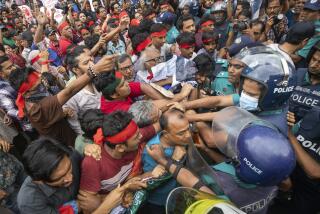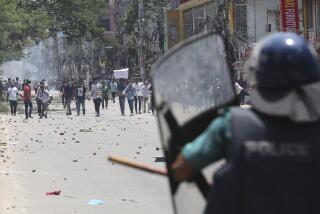Furious militants battle police at Pakistan’s Red Mosque
- Share via
ISLAMABAD, PAKISTAN — The Red Mosque became a focal point for renewed violence as it opened for Friday prayers, with militants battling police and an apparent suicide blast nearby killing at least 13 people.
The mosque in the heart of the capital was the scene this month of a raid by commandos who seized the compound from the heavily armed followers of a pair of radical clerics.
More than 100 people died, and a wave of reprisal attacks by militants left 180 more people dead.
The confrontation with militants, including Taliban and Al Qaeda-allied extremists based in the tribal areas straddling the Afghanistan-Pakistan border, has placed heavy new pressure on President Pervez Musharraf.
The Pakistani leader has been struggling with a burgeoning pro-democracy movement and the Supreme Court’s reinstatement this month of the chief justice, whom he had suspended in an apparent effort to fend off legal challenges to his reelection plans.
Pakistani authorities had expressed hope that renovating the mosque and reopening it for prayers would soothe militants’ anger and help lay the episode to rest. That proved to be a major miscalculation.
Protesters, many of them wearing traditional prayer caps, ejected a government-appointed cleric when he attempted to preside over Friday prayers, the most important of the Muslim week.
A crowd outside the compound hurled stones at riot police, who responded with volleys of tear gas.
The clashes erupted a day after government officials had shown off repairs to the battle-scarred house of worship, including a fresh coat of pale-yellow paint and the painstaking patching of bomb craters and bullet holes.
An adjacent seminary was demolished because the fighting had left it structurally damaged and unsafe, the government said.
Police set up metal detectors to check those arriving for Friday prayers for weapons. But the display of fury that followed appeared to catch them by surprise.
As worshipers flooded the compound, protesters scaled rooftops to inscribe the mosque’s Urdu name, Lal Masjid, on its dome. In a gesture of defiance, they splashed red paint on the walls of the mosque, which was named for its original red-brick exterior.
Others raised the mosque’s onetime standard, a black flag inscribed with the Muslim declaration of faith.
The explosion, coming several hours into the confrontation, occurred on the edge of busy Aabpara Market, a few hundred yards from the mosque compound. The blast was close to police barricades around the mosque, and most of those killed and injured were police officers.
The explosion shattered shop windows, left blood pooled in the street and sent passersby fleeing in panic. A senior Interior Ministry official, Syed Kamal Shah, said the explosion was believed to have been a suicide attack, with security forces as its principal target. In addition to the dead, dozens were injured.
By evening, protesters had been dispersed, and police were again in control of the compound, which sits in the middle of an upscale residential neighborhood in Islamabad. Police said about 50 protesters were arrested.
The U.S. Embassy warned American citizens to avoid the vicinity of the mosque, which is a short distance from Islamabad’s diplomatic enclave, the presidential building and the Parliament.
The protesters demanded the reinstatement of former chief cleric Abdul Aziz, who early in the eight-day siege tried to flee the mosque compound disguised in a woman’s head-to-toe covering, or burka, and high-heeled sandals.
He is now in the custody of Pakistani authorities.
Aziz’s brother and deputy, Abdul Rashid Ghazi, was killed in the raid, and cries from the mosque loudspeakers Friday hailed him and his slain followers as martyrs.
“Ghazi, the shedding of your blood will inspire a revolution!” protesters shouted.
Most moderate Pakistanis generally supported the storming of the mosque, whose students had launched a Taliban-style anti-vice campaign in the capital. But there is widespread public skepticism over the government-provided casualty figures and the claim that no women or children were believed to have been killed in the assault.
Musharraf has pledged to crack down on militants taking shelter in Pakistan’s tribal lands.
But the Bush administration is pointedly urging him to do more, particularly since a U.S. National Intelligence Estimate was released last week stating that the Al Qaeda terrorist network had regrouped in the border region and was stronger and more capable of major attacks than it had been for more than five years.
Militants struck another blow Friday in the southwestern city of Quetta, where assailants killed a special advisor to the chief minister of Baluchistan province, riddling his vehicle with gunfire. The official, Raziq Bugti, died at the scene, authorities said.
Special correspondent Zaidi reported from Islamabad and Times staff writer King from Istanbul, Turkey.
More to Read
Sign up for Essential California
The most important California stories and recommendations in your inbox every morning.
You may occasionally receive promotional content from the Los Angeles Times.













